part 4
FASHION CENTRAL

COSTUMING IS AN IMPORTANT PART OF GIVING YOUR FANTASY CHARACTERS THEIR IDENTITY. IT CAN BE USED TO DIFFERENTIATE A PIRATE AND A KNIGHT, OR IT CAN BE USED TO PLAY WITH CLICHéS. A CHARACTER IN A DRAB, DUSTY TUNIC MAY BE A POOR PEASANT OR HE COULD BE A PRINCE IN DISGUISE! USE THE VISUAL CLUES OF COSTUMING TO MAKE THE VIEWER GIVE YOUR CHARACTER A SECOND GLANCE.

Warrior

Warriors are very common, but very important fantasy world members. These adventurers have decided that in a world of myth and magic, a good old axe or sword is the most reliable weaponry. Wearing heavy, protective armor and wielding weapons both large and small, warriors can take a hit and fend off the enemy long enough for your fantasy gang to flee, or make some super fun and dramatic plot-twisting realization about who the bad guy is!

SHOULDER GUARDS
Okay, in real life shoulder guards aren't these big, ornate contraptions. They're small and to the point. In fantasy, shoulder guards can be drawn to look really unique and will greatly influence the look of your character's garb. Whether the guards are simple shapes with intricate detailing or giant, layered shoulders covered in spikes, they'll definitely give the impression of a warrior. If it looks cool, do it!
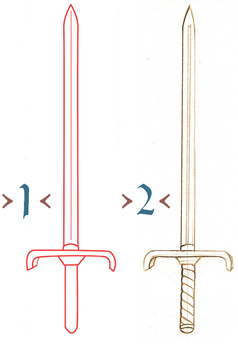
SWORDS
The sword is the most iconic warrior weapon out there. Far from cliché, they're just necessary for many, if not all, fantasy characters, They come in a variety of shapes and sizes, from light short swords that can be dual-wielded easily to giant two-handed broadswords, a challenge for most of us to even lift. Some swords are passed down as heirlooms, some are simply functional accessories, while others are mystical artifacts with ancient secrets. Pay special attention to the handle, because, in general, this is the part of the sword that will influence its look the most.

POLE ARMS
Pole arms are long, dangerous weapons that give your character a fantastic reach. They also make great props for guards and other characters when a sharp axe or double-edged sword simply won't do. Spearheads come in a variety of lengths. When you draw the head make sure that both sides are a near-perfect mirror of each other.

CAPES
A great billowing cape can add a lot of drama to your character. Remember that fabric bunches when it's pulled and fold lines will flow in the direction of the fabric's pull. Fabric also lays close to surfaces supporting it, and drapes downward where it's unsupported.
Ranger

Camouflage is very important to a ranger. Generally human, elf or a combination of creatures, they live outside the confines of a city. They may be part of a group of bandits who stake out the wilderness or self-appointed guardians of the forest. Either way, sticking to a palette of earth tones and greens will go a long way towards making your characters believable.
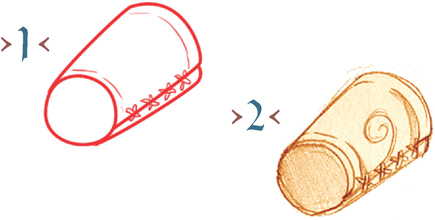
BRACERS
Bracers are relatively easy to draw. They will wrap around the lower arms of your character, so a curved line along each edge will help give a sense of dimension. The bracers may have exposed laces where they tie up.
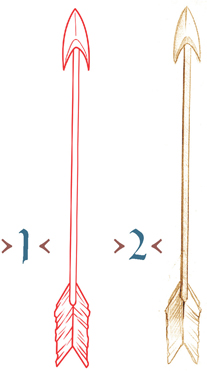
ARROWS
Arrows are delicate, tricky things to draw. The head of the arrow can be made of stone, metal or simply sharpened wood. Use a ruler for the shaft so that it looks nice and straight. Your ranger would have a hard time shooting a crooked arrow! The fletching at the end can be ragged or perfectly aligned, depending on how tidy you want your hunter to be.
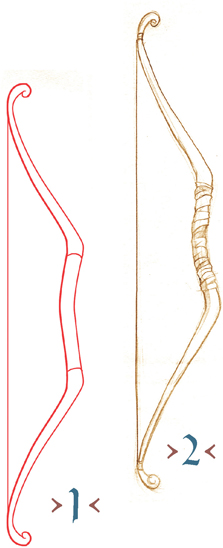
BOWS
Bows are the most common ranger weapon. They allow rangers to stay hidden, high up in the trees or behind a bush, out of sight, so that they can take out their enemies from afar. The bow itself is a simple shape, but it can be tweaked a little bit from character to character, giving each bow its own style. Remember that regardless of its shape, it will still need to be held and it will still have to have space for a drawstring.

QUIVERS
All those arrows have to go somewhere. If your character is running around with a bow and arrow, it only makes sense that he or she would also have a quiver of arrows strapped on tightly. Quivers come in a variety of different shapes, but they are all essentially tubes.
Rogue

Rogues are a common fantasy class that is full of your not-so-perfect heroes. Comprised of cat burglars, pickpockets, pirates and the rest of fantasy society's delinquents, these characters have little respect for rules. Ninety-nine percent of the time, rogues will look out for number one, often leaving the rest of your fantasy gang high and dry. The other one percent of the time, they will pull off surprising, selfless heroics, leaving everyone horribly confused.
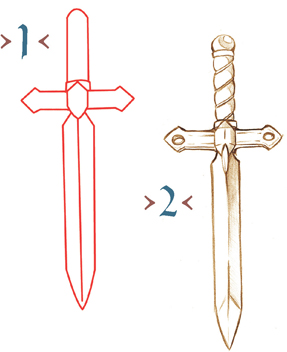
DAGGERS AND KNIVES
Daggers and throwing knives are classic examples of rogue weaponry. These characters do not openly carry weapons, preferring instruments that are easy to conceal should they have a brush with the wrong side of the law. Daggers can be as simple or as intricate as you like. Rogues that are more well-to-do might carry fairly ornate weaponry, while your common street thieves will favor simpler, less valuable tools. Use a ruler for the blade. Note how the dagger is straight and regular for most of its length. Near the end of the blade it tapers to a fine and deadly point.

BANDANAS AND HEAD WRAPS
Useful for holding back all that pesky hair when working over a lock or for use as a mask to conceal identity, a bandana makes a fantastic accent for your rogue's outfit. When drawing a bandana, the cloth will be tightly wrapped around the head, taking its shape. A few wrinkles may branch out from the knot on the back.

SATCHELS
Many rogues are thieves, and thieves steal a lot of stuff, and that stuff has to go somewhere. Even if your rogue is not a thief, he or she still needs lock picks, flash powder or other goods of the trade. A simple bag with a lumpy or boxy shape with a flap pulled over to secure it is best. It could button shut, buckle shut or be tied shut.
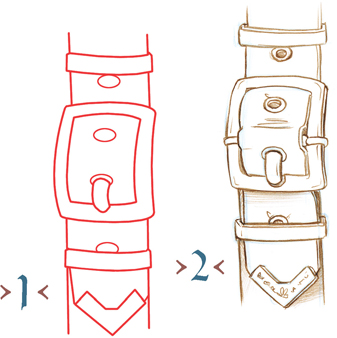
BUCKLES AND BELTS
Rogues use belts to hold multiple tools, such as knives, lock picks and perhaps a purse of coin or three, depending on if they've had a successful evening. Because they are so intricate, belt buckles can be intimidating to draw. Simplify the buckle into a hollow rectangle. Overlap one end of the belt over the other and include a strip of metal or leather near the edge so that the end of the belt doesn't flap about.
Mage

Masters of magic and all that is explosive and sparkly, mages and wizards are an important part of most fantasy worlds. These arcane masters know the rhyme and reason behind all the crazy things that can happen in your fantasy world, and they use this knowledge to pull off a few crazy stunts of their own! Mages can be dressed in anything from rich, whimsical robes to a simple tunic and britches.

SPELLBOOK
Many mages have a book of spells that they read from when they cast a spell. When drawing your book, consider adding details to it to make it look intricate, thick and special. Books in many fantasy worlds would be hard to come by, let alone contain magical mysteries. As such, if your character happens to own one, it's probably very decked out in metal and leatherwork to protect what's inside.
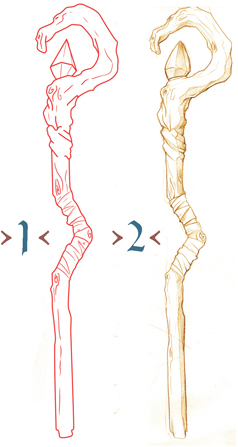
STAFFS
Mages often carry intricate looking staffs that they use to channel their magic. A staff can be very ornate and delicately crafted or completely natural. Draw a natural-looking stave with an organic, irregular outline. Then add delicate lines showing knots in the wood and paths that the grain follows.
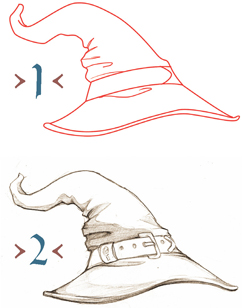
HATS
A floppy wizard hat is one of the most iconic costuming pieces you can add to your mage. The hat may be tall and pointy. It can also be battered and flopped over, having seen better days if the mage is well travelled. The brim of the hat may still be stiff even if the point of it is not, or vice versa.

FAMILIAR
Your sorcerers may have a creature companion to accompany them on their journey. Mages are very wrapped up in their magic, so the creature itself may be just as magical. Consider the personality of your familiar. Is it a cute and cuddly companion, or a sly trickster with ulterior motives?
Cleric
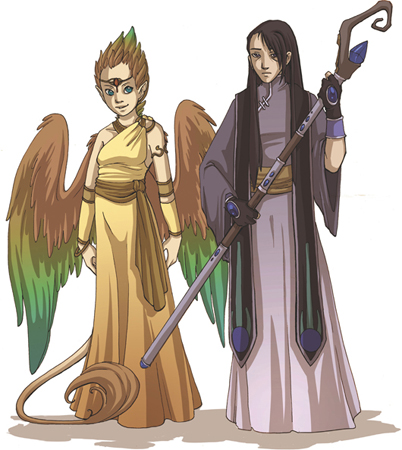
A fantasy world can be a dangerous place. What with the dragons, bandits, swords and all. Luckily for them, there's usually a cleric not too far behind, ready to heal wounds or say a little prayer.

CIRCLET
Accessorizing your cleric's head can be done with a variety of hats, but also consider using a circlet. The circlet could be delicate and thin or a thick metal band.
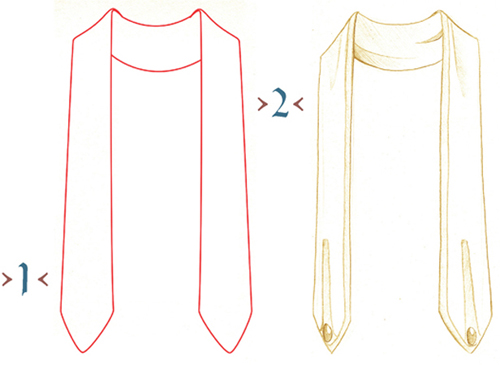
SCARVES
A long, carefully pressed scarf draped over the shoulders is a very distinctive piece of costuming and it gives you a chance to incorporate different colors of fabric into your character's garb. Remember to bend the garment around your cleric's shoulders so that the outside is always facing out.

SASHES
A sash tied around the waist is a useful place to store small scrolls or vials of liquid. Simply draw the sash as you would a belt around the waist. Then erase out a small spot for a knot and draw two ties of loose fabric branching out from the knot.
Samurai

Fantasy worlds are more diverse than our own. Not only do you have human culture to deal with, but that of elves, orcs and other fantasy races. You can of course create your own unique set of styles for each race, or you can draw upon the rich diversity present in human history to use as inspiration for creating different cultures for your races. Drawing from Eastern culture is a great way to give a new twist to your warriors and mages.
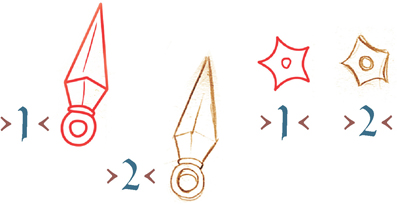
KUNAI AND THROWING STARS
Samurai need a variety of throwing weapons, and kunai and throwing stars fit the bill. These small but deadly weapons are made of simple shapes and can really be used to dramatic effect when drawn in the midst of a battle.

CONICAL STRAW HATS
Pointy hats are great for keeping your character cool in the midday sun. They are equally useful for hiding the identity of the mysterious stranger passing through town, head hung low. When drawing a pointy hat, remember that it does not just sit way on top of your character's head. It will partially obscure a section of the skull. Add a drawstring to ensure that the hat does not topple off your character's head.

FANS
Fans are an elegant, mysterious accessory that any character can use. A fan can mask a face or hide a dagger. Begin with a series of evenly spaced sticks branching out from the center point, where the fan folds together. Connect these sticks with two strips that follow the edges of the fan down to a point a little over halfway down. Leave a small amount of the wooden sticks exposed to give your character a place to hold the fan.
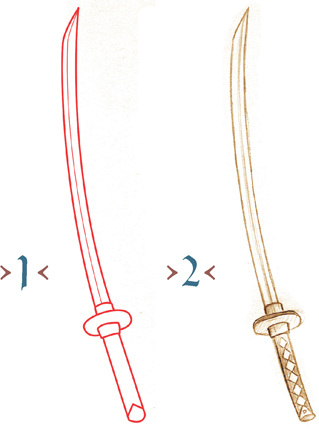
KATANA
Eastern swords are very distinctive in design. Take this into account when you're drawing your katana. Do you want a curved or straight blade? How long is the blade? What is the length of the handle? Will it be used for decorative purposes, for combat, or for both?
Nobles
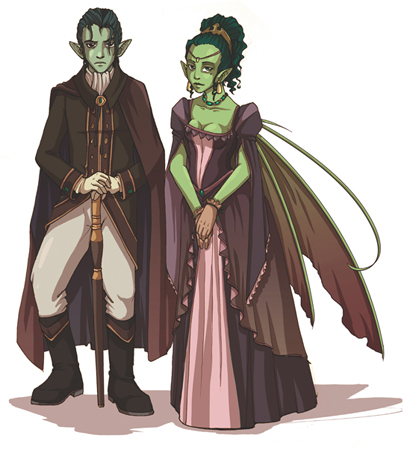
Nobility and the upper class usually dress in finer garb than the rest of populace. Even if your characters are not members of the nobility themselves, encounters with nobles are a great chance to explore some lavish costuming and settings.
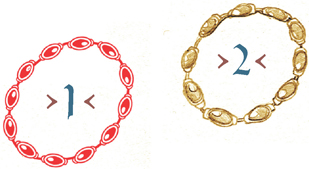
JEWELRY
Few things get across a lavish display of wealth as well as jewelry. Bedeck your nobles in necklaces, rings, bracelets, pins, fancy buttons and earrings. When drawing jewelry, the trick is to make it specific enough that you know what it is, while not going overboard with detail or there will be too much packed into a small space, which will detract from the rest of your drawing.
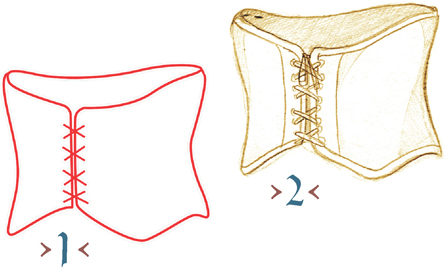
BODICES
A bodice is an article of clothing worn over a dress. It is a great way to visually separate the top half of the dress from the skirt, and will allow you to add more color to your drawing. You can make your bodice lace up in the front or the back, depending on whether you want the lacings to show.

CANES
An intricately carved cane is a good way to show sophistication and wealth. Your cane may be simple, or bedecked in jewels and decorative tooling.

NECKTIES
Neckties come in a variety of styles and knots, and change with the time period and fashion trends. Regardless, a necktie is a great way to show sophistication and care with your character's appearance.
Peasants

In a world of wizards and dragons, peasants may not seem like the most interesting thing around… they're so ordinary. I mean, come on, that little twerp can't throw a fireball or fly. But wait. If everyone in your world can fly and throw fireballs, then what makes these magical powers extraordinary? How much more dramatic is it if your hero-to-be started off with nothing and realized he or she was destined for great things? Heck, maybe your peasant never does become a hero. A peasant's story might be about being an ordinary person, surviving in a world where everything else is dangerous and powerful.

HEAD COVERINGS
For both functionality and modesty, you might want to give your peasants head coverings. The shape and color of your hat will go a long way towards making your character unique in a class known for its simple clothing and drab colors.

VESTS
Short vests, with or without pockets, are a common piece of clothing that can add variety to your peasant's attire. This piece of clothing is relatively simple to construct; just remember that it will wrap around your character, layering over the clothing.
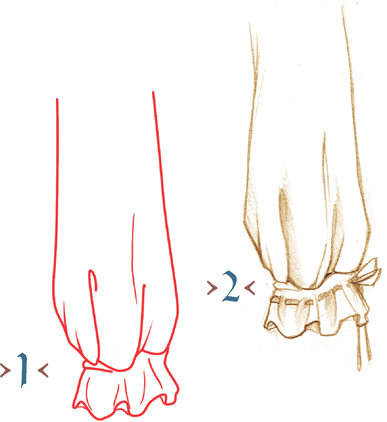
SLEEVES
Billowy sleeves are a must for peasants. The sleeves can be short or long, tied tight with drawstrings or ribbons.
FANTASY IS…FANTASTIC?!
Fantasy is a great genre to draw in, because you can draw anything you want, and tell stories without limitations! Remember this, and don't let this book limit you. There are some good ideas and foundations in here, but these tutorials alone are not what is going to create amazing, imaginative art: It's you! Take what you've learned and let your imagination and characters go whatever direction they would like to take you!

A THANK YOU
Thank you for reading my book. I hope that the tutorials were helpful, and that you enjoyed learning from them as much as I enjoyed making them. I wish you all the best in creating your own fantasy characters and worlds!